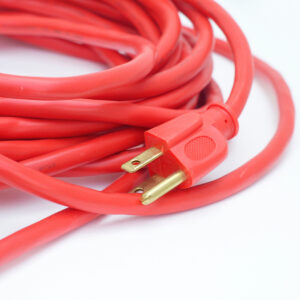
Remember, an extension cord is just a bundle of insulated wires with a plug on each end. The current in the cord creates heat and when there is too much power, it can overheat, melt, and create an electrical fire.
As we head into the holiday season, many homeowners will dig out their older extension cords to power up lights and decorations. Before you dig out that box of tangled cords, learn the different features of an extension cord, what causes extension cord fires, and how to properly use an extension cord.
Features and Types of Extension Cords
Not all extension cords are created equal. Just like other tools around the home, you will want to select the one that is designed for the job. Some extension cords are meant for lower amps, and others can handle tougher jobs like powering appliances or lighting.
Here are the different features and types of extension cords to choose from depending on the need:
- Indoor Vs. Outdoor: The difference between indoor and outdoor extension cords is how they are constructed. Indoor cords are generally thinner, shorter, and are less powerful than their outdoor counterparts. Outdoor extension cords are designed to stand up to the elements and have a thick, durable layer of insulation.
- Plug Types: Most extension cords come with two- or three-prong plugs and some specialty cords for high amperage devices and uses such as RVs and construction tools have additional receptacles. The third prong is a grounding element and reduces the risk of electric shock and fires.
- Amperage, Gauge & Cord Length: Choosing the best extension cord relies on understanding how amperage, cord length, and gauge ratings work. They each affect the performance and power of an extension cord. Amperage is how much power a cord is made to handle. The gauge (measured in terms of AWG, or American Wire Gauge) is the diameter of the conductors inside an extension cord. And the cord length determines the power capacity. The longer the cord, the more electric resistance.
Understanding how each feature and type of cord works will help you choose the best type for your needs.
Learn About Our FIRE Damage Restoration Services
Causes of Extension Cord Fires
According to the Electrical Safety Foundation International (ESFI), there are approximately 3,300 home fires each year that are caused by extension cords. These fires are often the result of misuse. The most common reasons extension cords cause a fire are:
- Overloaded Cords: There are many different types of extension cords and not every one can handle powering electric-hungry power tools, generators, or machinery. If you are trying to use a power drill, do not choose one that is designed for interior lighting.
- Damaged Cords: Frayed, damaged cords are a fire risk and should be discarded. When the insulation on a cord is split or removed, the interior conductors can generate so much heat it can cause a spark, and then a fire. If you have a damaged extension cord, it’s best to replace it with a new one.
- Old Extension Cords: As with most consumer products, technology and safety have increased dramatically over the years. Older extension cords may not have the same safety features as new cords and can be a greater fire risk.
Extension cord fires are preventable. If you need to use an extension cord inside or outside your home, be sure to inspect it before use and know which type of cord will meet your needs.
Proper Use of Extension Cords
With the proper use of extension cords, you can prevent a fire from starting at your home. Here are several extension cord safety tips to keep in mind when using a cord around your house:
- Use the correct cord for your purpose. Do not use indoor cords for outside jobs.
- Use the correct length cord. Do not plug two cords together to reach power.
- When not in use, store cords indoors in a cool, dry place.
- Water and electricity do not mix! Never use an extension cord when it is wet.
- Extension cords are not meant to be covered or burdened by weight. Do not drive over them or place them under flooring such as carpeting.
- Be sure the extension cord is fully positioned into the electrical outlet before you connect anything to it. Never force a fit!
If you are using an extension cord and a fire does start, unplug the cord if you can do so safely, and extinguish the fire with a proper fire extinguisher. If the fire is intense, call 911 immediately.
Fire Restoration Services with Reynolds Restoration
While we hope you never need our services, Reynolds Restoration Services can help restore your home to its pre-loss condition after a fire. Our emergency services team has been helping homeowners for more than 15 years after they’ve experienced a fire. We are on-call 24/7 to respond to an emergency and specialize in fire damage restoration.
With offices in Harrisburg, Pa., Philadelphia, Pa., and the Baltimore, Md./DC Metro region, our emergency restoration team can be on-site quickly to help you begin the process of restoring your home or office after a fire. We work closely with your insurance company and you to make sure your project is taken care of efficiently and professionally.

President of Reynolds Restoration Services. Over 20 years of experience in the emergency restoration industry.

